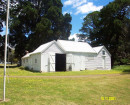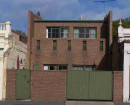CAST IRON URINAL
NICHOLSON STREET EAST MELBOURNE, MELBOURNE CITY
-
Add to tour
You must log in to do that.
-
Share
-
Shortlist place
You must log in to do that.
- Download report
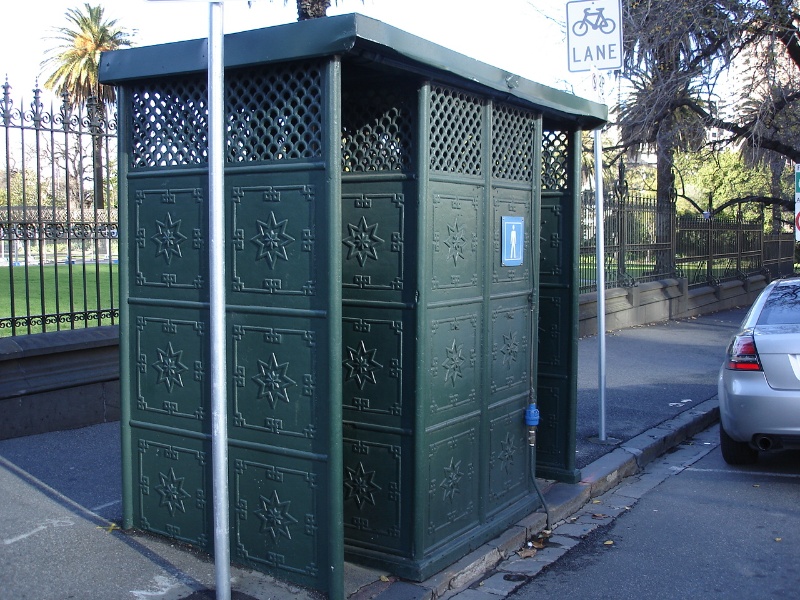

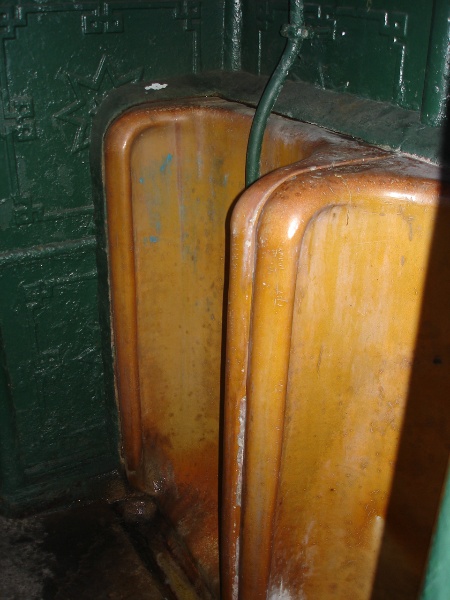
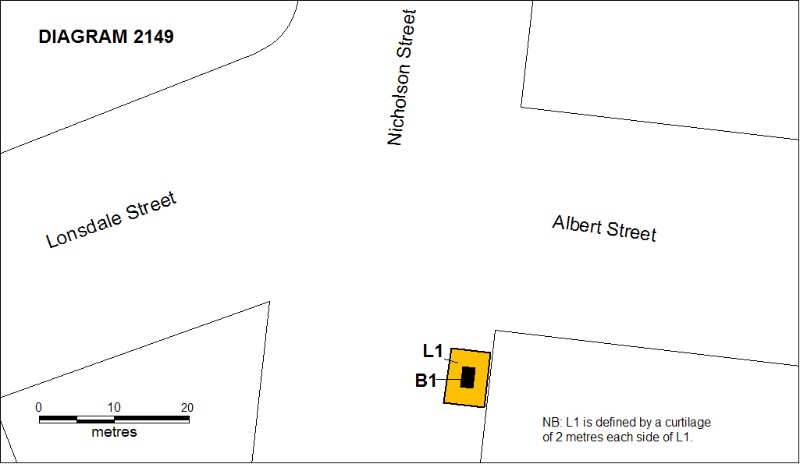
Statement of Significance
What is significant?
The cast iron urinal in Nicholson Street, East Melbourne, is one of more than forty erected by the Melbourne City Council between 1903 and 1918, of which eight remain, all still being used for their original purpose. The structures employed a prefabricated system which enabled the urinals to be assembled on site or dismantled and relocated if required. This occurred often, as their prominent locations in the streets sometimes offended contemporary standards of public decency. All of these urinals were cast by C Monteith & Sons, ironfounders, of South Melbourne, whose name plate appears on most of them. Together with the new underground public toilets, built from 1902, they were connected to the new underground sewerage system, constructed by the Melbourne Metropolitan Board of Works from the 1890s and connected in the central city area in 1898. The date of erection of the urinal in Nicholson Street is unknown.
The eight surviving cast iron public urinals in the City of Melbourne were made using a prefabricated system of interlocking cast iron panels and posts. The 600 mm square cast iron panels slotted between 70 mm diameter cast iron columns, fixed at the base to bluestone footings and at the top to a cast iron channel which also serves as a gutter. Plans varied from three modules (for a single stall) to six modules (four stall). The majority of cast iron urinals erected between 1903 and 1918 were four modules long, containing two stalls. The Nicholson Street urinal is a two stall urinal with terracotta stalls. It has been covered by a roof, but the cresting remains beneath this.
How is it significant?
The public cast urinal in Nicholson Street is of historical and architectural significance to the State of Victoria.
Why is it significant?
The cast iron urinal in Nicholson Street is historically significant as one of a number of such structures erected by the City of Melbourne between 1903 and 1918, which were among the first public toilets in the City connected to the new underground sewerage system. They are a reminder of Melbourne's transition from a smelly disease ridden city to a healthier, cleaner and more modern metropolis in the first two decades of the twentieth century. The provision of a much greater number of public facilities for men compared to those for women in the city is a reflection of the continuing gender inequalities in Victorian society at the time.
The cast iron urinal in Nicholson Street is of architectural significance as a rare example of an unusual building type and of early twentieth century civic design, demonstrating the elegant street furniture developed in Victoria at the time. Although serving a basic function, the urinals were still designed to be an attractive addition to the city streetscapes.
-
-
CAST IRON URINAL - History
History
(This history is largely adapted from Andrew Browne-May, Melbourne Street Life, pp 95-107; together with the Report produced by Angela Taylor in association with the HBC, June 1995; and the National Trust Classification Report for the group .)
Until 1859, Melbourne had no public toilets. Facilities were only available in hotels and markets, and the secluded corners and laneways of the city were frequently used by men needing to relieve themselves. The lack of public facilities led to numerous complaints being made to the Melbourne City Council about the 'indecent nuisances' being committed in public places. A growing awareness of European advances in such technology, and the opening of the Yan Yean reservoir in 1858, which meant that piped water was now available, led to the building of the first public urinal in 1859 on the pavement outside the Post Office in Bourke Street. However prudish nineteenth century attitudes to bodily functions meant that this prominent location became the focus of complaint, and it was soon moved to a less prominent site on the south side of Flinders Street near King Street.
Between 1859 and 1918 Melbourne City Council erected many urinals around the city in response to community pressure to clean up the streets and to safeguard public decency and public health. The first public conveniences were only for men: urinals built over the stinking open drainage channels, three feet wide and a foot and a half deep, which lined the city streets and drained into the Yarra. It was said that urinals being placed over the gutters enabled a man 'to use the facility and hold on to his horse at the same time' (Schauble, 'Monuments in lieu of memories').
The first urinal was a rough structure of iron and timber, but later ones were more elaborate structures, the one person urinals being circular in plan and resembling the decorative French pissoirs. In 1860 the Argus reported on a new 'commodite', 'a neat little pagoda-kind of building' on a bluestone base, in the centre of the roadway at the intersection of Bourke and Swanston Streets. Its lower portion was constructed of iron panels with upper glass panels carrying 'sundry business announcements, readable only from the outside'. On its roof were a clock and a vane, the whole structure being illuminated at night. By the 1870s some cast iron urinals had gas lamps attached. As the number of public toilets in the city increased the outer parts of the municipality, such as Carlton and South Yarra, became the focus of complaints.
Complaints about the urinals were many, with detractors objecting to the visual pollution, their use as a haunt for objectionable characters, their smell and their general effect on public decency. Men commonly 'adjusting their dress', which then involved numerous buttons, in public view as they left offended contemporary standards of decency. With the approach of the 1880 International Exhibition attention was drawn to the urinal at the corner of Lonsdale and Stephen (Exhibition) Street, which was a gathering point for 'objectionable characters'. The council fitted iron spikes to the nearby stonework to stop any lounging about. The location of urinals became a particular problem to the Council, the Assistant surveyor noting that 'no matter when a urinal is erected, there is always a certain amount of captious criticism'. The complaints of citizens were parried by moving contentious new structures to less controversial sites. By the 1880s concerns about public health were added to those about public cleanliness and decency. A vigorous public health campaign led by the medical profession linked dirt and disease, and called for a cleaner and healthier city.
It was not until after the establishment of the Melbourne Metropolitan Board of Works in December 1890 that Melbourne's underground sewerage system began to be constructed. By 1902 a number of new underground public toilets in the city, for women now as well as men, were being connected to the new sewerage system. From 1903 urinals were also being connected, and their number increased rapidly. The dominance of hoteliers on the City Council ensured that facilities were usually close to their establishments (Schauble, 'Monuments in lieu of memories'). The population of Melbourne increased rapidly in the first two decades of the twentieth century, and many of the city's offices and department stores were also built at this time. City businesses and department stores started requesting the Council to install public urinals at convenient locations near busy intersections for their clients. By 1911 there were 71 urinals with 210 stalls in Melbourne. Between 1903 and 1918 at least forty of the cast iron urinals were erected on footpaths, in road reserves at intersections near tram stops, and in public gardens. Only eight of these remain.
The predominance of public toilet facilities for men in the city compared to those provided for women in the early twentieth century demonstrates the continuation of the nineteenth century view that a woman's place was in the domestic rather than the public realm. While the first urinal was built in 1859, the first women's public toilet, the underground facility at the corner of Russell and Bourke Streets, was not constructed until 1902. This was despite the fact that by 1901 females made up one third of all city workers, and many more visited the city for business, to shop and to socialise. By 1918 six underground toilets had been built for men, and only three for women; well into the twentieth century there were always many more facilities provided for men than for women.
In the 1860s urinals may have been imported from Britain, but local foundries began casting an elaborate circular one person urinal in the 1870s. By the 1920s most of these had been removed, and none now remain. The type still found in the city is the rectangular plan two or four person urinal created between 1903 and 1918. These are of cast iron, cast by C Monteith & Sons, iron-founders, of South Melbourne. They employed a prefabricated interlocking post and panel system which enabled the urinals to be erected on site, or dismantled and relocated.
The foundry of C Monteith & Sons was established soon after 1870, when the experienced iron-founder Charles Monteith arrived in Melbourne from Falkirk, Scotland. The firm produced ornamental cast iron work, including iron for the Collingwood Town Hall, and at one time it employed over forty men and exported its work to other colonies. Charles Monteith Junior designed the patterns for the iron work produced by the firm in the nineteenth century, and when Charles Monteith Senior died in 1903 it is likely that his son designed the ornamental pattern of the panels and lattice ventilation grille for the firm's cast iron urinals. The pattern of the Melbourne urinals shows marked similarity to one in the 'Catalogue of Pressed Metal and Cast Iron Conveniences' of the firm of McDowell, Steven & Co, Glasgow, and may well be Scottish (rather than Parisian) in origin. No copy of the catalogue has apparently survived.
References
National Trust Classification Report.
Andrew Browne-May, Melbourne Street Life, pp 95-107.
John Schauble, 'Monuments in lieu of memories', The Age, 1 July 1980, http://150.theage.com.au/view_bestofarticle.asp?intid=706
Angela Taylor, Report produced by Angela Taylor as a Master of Arts in Public History Project, Monash University, in association with the Historic Buildings Council, June 1995.
Description
The eight surviving cast iron public urinals in the City of Melbourne are examples of the prefabricated urinals made using Monteith's portable system. This comprises 600 mm square cast iron panels slotted between 70 mm diameter cast iron columns fixed at the base to bluestone footings, and at the top via a cast iron channel which also serves as a gutter. A great advantage of this system was that the urinals could be assembled on site, with the posts and panels being bolted together, or dismantled and relocated. Plans varied from three modules (for a single stall) to six modules (four stall). The majority of cast iron urinals erected between 1903 and 1918 were four modules long, with two stalls. The only surviving four stall urinal is situated in the median strip at the north-east corner of Queensberry and Errol Streets, North Melbourne. Those urinals on footpaths (rather than on median strips) open directly onto the road, rather than onto the footpath, presumably for greater discretion. All except the Flinders Street urinal retain the makers' plates attached to the exterior and/interior walls.
The cast iron urinals are functional but elegant structures. At the centre of each cast iron panel is an eight-point star, enclosing a smaller star, the whole bordered by a key pattern. The ventilation grille at the top of each panel has a delicate fish scale design. The gutter sits behind a crested iron top plate. Inside curved porcelain stalls in some urinals are divided by a circular column topped with a round knob, and flushed by a wall cistern with a pull-chain. The floors were originally black and white encaustic tiles, but most have been replaced with concrete.
CAST IRON URINAL - Plaque Citation
This is one of only eight remaining of the more than forty prefabricated cast iron urinals, linked to the city's new underground sewerage system, erected by the City of Melbourne between 1903 and 1918.
CAST IRON URINAL - Permit Exemptions
General Exemptions:General exemptions apply to all places and objects included in the Victorian Heritage Register (VHR). General exemptions have been designed to allow everyday activities, maintenance and changes to your property, which don’t harm its cultural heritage significance, to proceed without the need to obtain approvals under the Heritage Act 2017.Places of worship: In some circumstances, you can alter a place of worship to accommodate religious practices without a permit, but you must notify the Executive Director of Heritage Victoria before you start the works or activities at least 20 business days before the works or activities are to commence.Subdivision/consolidation: Permit exemptions exist for some subdivisions and consolidations. If the subdivision or consolidation is in accordance with a planning permit granted under Part 4 of the Planning and Environment Act 1987 and the application for the planning permit was referred to the Executive Director of Heritage Victoria as a determining referral authority, a permit is not required.Specific exemptions may also apply to your registered place or object. If applicable, these are listed below. Specific exemptions are tailored to the conservation and management needs of an individual registered place or object and set out works and activities that are exempt from the requirements of a permit. Specific exemptions prevail if they conflict with general exemptions. Find out more about heritage permit exemptions here.Specific Exemptions:Minor repairs and maintenance that do not impact on the heritage significance of the place can occur without the need for a permit. Other works will require either the written approval of the Executive Director or permit approval.
CAST IRON URINAL - Permit Exemption Policy
The purpose of the Permit Policy is to assist when considering or making decisions regarding works to the place. It is recommended that any proposed works be discussed with an officer of Heritage Victoria prior to them being undertaken or a permit is applied for. Discussing any proposed works will assist in answering any questions the owner may have and aid any decisions regarding works to the place. It is recommended that a Conservation Management Plan is undertaken to assist with the future management of the cultural significance of the place.
The significance of the place lies in its rarity and intactness as an early twentieth century prefabricated cast iron urinal which has remained in continuous use since its erection. Both the cast iron structure and the terracotta stalls inside are integral to the significance of the place, and any alterations that impact on their significance are subject to permit application.
General Conditions:
1. All alterations are to be planned and carried out in a manner which prevents damage to the fabric of the registered place.
2. Should it become apparent during further inspection or the carrying out of alterations that originally or previously hidden or inaccessible details of the place are revealed which relate to the significance of the place, then the exemption covering such alteration shall cease and the Executive Director shall be notified as soon as possible.
3. If there is a conservation policy and plan approved by the Executive Director, all works will be in accordance with it.
4. Nothing in this declaration prevents the Executive Director from amending or rescinding all or any of the permit exemptions.
5. Nothing in this declaration exempts owners or their agents from the responsibility to seek relevant planning or building permits from the responsible authority where applicable.
-
-
-
-
-
ROSAVILLE
 Victorian Heritage Register H0408
Victorian Heritage Register H0408 -
MEDLEY HALL
 Victorian Heritage Register H0409
Victorian Heritage Register H0409 -
DRUMMOND TERRACE
 Victorian Heritage Register H0872
Victorian Heritage Register H0872
-
'Mororo' 13 Oxford Street, Malvern
 Stonnington City
Stonnington City -
1 Arnold Street
 Yarra City
Yarra City -
1 Austin Street
 Yarra City
Yarra City
-
-








